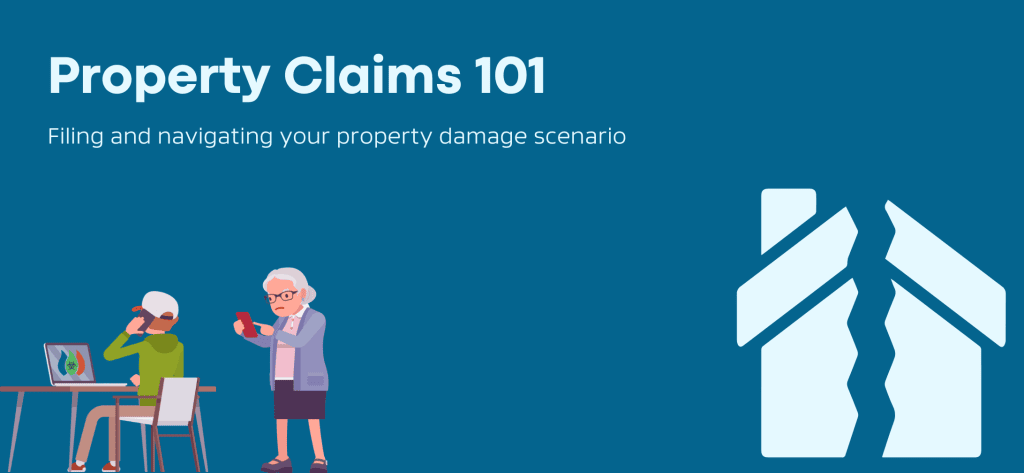
Property Claims 101
Filing a property damage claim can be a challenging process, especially for those navigating the complexities for the first time. While the need to file a claim may arise unexpectedly, understanding the fundamental steps ahead of time can help you maneuver through insurance procedures like a pro!
In this guide, we’ll walk you through the basics of filing a property damage claim, shedding light on the uncommon terminology and the ever-evolving best practices in the industry.
Although no two situations are the same, following these four steps will set you up for success, no matter the circumstances.
Step 1: Contact Your Insurance Professional(s)

The first and most crucial step in the claims process is reaching the right person. Depending on your situation, this could be your agent, broker, or an individual from your insurance carrier.
While most agencies/brokerages prefer or require you to file a claim through them, there are many that operate differently. Sometimes, a carrier prefers that all claims get filed online via an app or portal, or over the phone with a toll-free number dedicated solely to their claims department.
While there are multiple ways to file a claim, simply making contact is the best place to start. Reach out wherever you are most comfortable, and you will be directed from there.
Once you’ve arrived at the right place, opening the claim is relatively straightforward. Be prepared to provide any and all information you can, including the timeline, scope of damage, belongings impacted, and current state of your property.
Step 2: Contact A Licensed Professional
Depending on the nature of your claim, the contractor or specialist needed to clean, remove, or replace the areas impacted by damage, will vary. Plumbers, Electricians, General Contractors, Cleaners, and a plethora of other entities may be involved throughout the lifetime of your claim/project. For this reason, it’s hard to say where the BEST place is to start. As a rule of thumb, if the damage could get worse as time passes, emergency services are likely necessary.
While you may not know who to contact initially, our team is always available to assist in navigating the winding road to recovery.
No matter the entity you choose to contact, the Minnesota Department of Commerce strongly urges property owners to vet all building contractors by confirming they are licensed by the Minnesota Department of Labor and Industry.
Additionally, when receiving proposals, be sure the contractor’s name, phone number, address, and license number are visible on the proposal.

3) Stay Active

Even with assistance from industry professionals like Dryco, maintaining an active role in the claims process is essential. Insurance companies consider you their primary client and decision-maker; actively contribute to your claim by providing necessary information, promptly. This could include updating your adjuster on new bids you receive, new problems that are discovered, and any issues with the process along the way. What you put into your claim, is most commonly, what you get out of it.
Insurance is not the enemy within a property damage claim, and the most positive results come when all parties work towards a mutually beneficial solution.
4) Receiving Payment and Closing the Claim
A claim is closed after: The damage is deemed uncovered, The policy limit is reached, the allotted time for a claim to be open, passes, or final payment is distributed to the homeowner and all other parties.
When an adjuster visits your property to inspect for damage, they will create an estimate for what they find, and typically write a check up-front (So long as they determine the damage as covered). This payment is for the cost of the claim, but is not a final dollar amount. Even if you use the funds to pay for the damages, new funds can still be issued in the future.
At Dryco, our role as a contractor is to provide you with an estimate that is approved by yourself and insurance, beforehand, in order to minimize or eliminate additional funds you must pay out-of-pocket. Our estimates contain the cost of the work required to bring you back to pre-loss condition. Nothing more, and nothing less.
Once the work is completed, the contractor will issue an invoice to you or the insurance company. When payment is issued directly to the contractor, confirm with this entity that it was received, so that your role is complete. If payment is issued to you, the property owner, you are then responsible for paying the contractor.
In situations considered an emergency, it is likely that work will be performed before a final estimate is created. For example, during a water loss, standing water will likely be removed before creating an estimate, in order to halt further damage. When emergency measures are taken, aspects of the work should be documented by the contractor (and homeowner if necessary), in order to receive payment for those services.
As alluded to, the key to receiving the appropriate payment for a claim is through proper documentation. Keep time logs, receipts, and inventories so that Insurance companies are able to see exactly what they are being charged for.

Additional information and guidelines to make sure you don’t get left behind in the claims process:
Stay Informed/Utilizing Technology:
In the ever-evolving landscape of insurance, staying informed is crucial. Changes in best practices are common, and what was considered standard procedure a year ago, might be outdated today. Technological advancements have significantly influenced how claims are filed and managed, ushering in a more automated process.
With technology playing a pivotal role in modern claims management, individuals less familiar with these advancements may find themselves facing additional hurdles. While the shift towards automation has streamlined certain aspects of the process, it can be daunting for those that are less than confident in the digital landscape.
A simple question that may help you determine your aptitude for the technology era is: “Are you prepared to document all aspects of your claim using your phone or computer?”
As the average individual moves closer and closer to owning all the tools needed to document a claim in great detail (pictures, scans, sketches, inventory), the more responsibility we can anticipate them to have. While only time can tell, it is very likely that the future of filing and tracking claims will be completely digital.
Borderline claims:
A common situation that many homeowners encounter after discovering property damage is whether or not the damage constitutes opening a claim. Even though the damage may be covered by insurance, the decision to file a claim isn’t always that easy.
In most cases, involving insurance in a property damage scenario will significantly increase the time it takes to solve the problem. This is solely due to the addition of a new party(ies) that have a say in how things are handled. When a claim is opened, an adjuster will review each stage of progress to ensure the work being done is within the guidelines of the policy. Similarly, if you begin your recovery without opening a claim, but decide to do so when the costs become significant, the adjuster will then need to backtrack the progress up to that point.
When it comes to predicting the total cost required to repair your property, there’s simply no way to be certain. One rule of thumb to keep in mind: reconstruction costs typically come out to 2-5 times more than the costs of mitigation. For example, a $2,500 water loss, which involved demolition, drying, and cleaning, may cost $10,000 to reconstruct. In this case, opening a claim may make the most sense. On the other hand, a $1,000 water loss that can be reconstructed for $3,000, may be worth handling out of pocket, as the cost of your deductible, the increased time the project will likely take, and the risk of being dropped by your current carrier, could outweigh the benefit of opening a claim.
Conclusion
Without a doubt, undergoing a property damage claim is a daunting task. However, understanding the basics and seeking guidance when you need it, can significantly ease the process. As technology continues to shape the insurance landscape, being adaptable and staying informed is key. Remember, you’re not alone—trusted professionals are available to help you navigate these obstacles and get your life back on track.